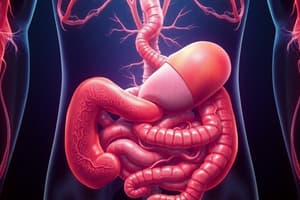Podcast
Questions and Answers
Why might a developer choose an iterative software development model instead of a waterfall model?
Why might a developer choose an iterative software development model instead of a waterfall model?
- To reduce the need for customer involvement during development.
- To accommodate changing requirements and incorporate feedback throughout the development process. (correct)
- To minimize initial planning overhead and documentation.
- To ensure each stage of development is perfectly completed before moving to the next.
Which type of testing is usually performed by end-users or clients to ensure the software meets their expectations?
Which type of testing is usually performed by end-users or clients to ensure the software meets their expectations?
- Acceptance Testing (correct)
- System Testing
- Unit Testing
- Integration Testing
What is the primary goal of refactoring code?
What is the primary goal of refactoring code?
- Improving the internal structure of the code without changing its external behavior. (correct)
- Optimizing the code for faster execution speed at the expense of readability.
- Adding new features to the software.
- Fixing bugs and errors in the software.
In the context of version control (e.g., Git), what does branching allow developers to do?
In the context of version control (e.g., Git), what does branching allow developers to do?
Which design pattern promotes loose coupling between objects by defining a one-to-many dependency between objects so that when one object changes state, all its dependents are notified and updated automatically?
Which design pattern promotes loose coupling between objects by defining a one-to-many dependency between objects so that when one object changes state, all its dependents are notified and updated automatically?
Flashcards
CamScanner
CamScanner
A mobile application for scanning documents using a smartphone camera.
Document Scanning
Document Scanning
The process of converting physical documents into digital format.
Smartphone Camera
Smartphone Camera
A built-in camera feature on a mobile device used for capturing images and videos.
PDF Format
PDF Format
Signup and view all the flashcards
OCR Technology
OCR Technology
Signup and view all the flashcards
Study Notes
Introduction & Divisions of GIT + Abdominal Quadrants
- The abdomen is the part of the trunk below the thorax.
- The abdominal cavity is a musculomembranous cavity bounded by the diaphragm superiorly and the pelvic inlet inferiorly.
- Abdominal viscera include major components of the gastrointestinal system, urinary system (kidneys and ureters), suprarenal glands, and major neurovascular structures.
- The abdominal wall is made of skeletal elements : L1-L5 and their intervertebral discs, pelvic bones, rib XII, and the xiphoid process.
- Other muscles that comprise the abdominal wall include quadratus lumborum, psoas, and iliacus muscles, extending into the thighs. These are major hip flexors.
- The lateral parts of the abdominal wall consist of three layers of muscles: transversus abdominis, internal oblique, and external oblique.
- Anteriorly, the rectus abdominis(segmented muscle) runs between the inferior thoracic wall and the pelvis.
- The abdominal cavity holds a central gut tube (gastrointestinal system) suspended from the posterior wall, partially from the anterior wall, by thin sheets of tissue (mesenteries)
- The abdominal cavity is lined by peritoneum, composed of an epithelial-like single layer of cells (mesothelium) and a supportive layer of connective tissue, similar to the pleura and pericardium in the thorax.
- Parietal peritoneum lines the abdominal wall, while visceral peritoneum covers suspended organs.
- Abdominal viscera can be categorized as either intraperitoneal or retroperitoneal.
Intraperitoneal Organs
- Intraperitoneal organs are enveloped by visceral peritoneum.
- Examples include the stomach, liver, and spleen.
Retroperitoneal Organs
- Retroperitoneal organs are not associated with visceral peritoneum, but they are covered in parietal peritoneum only covering the anterior surface.
Divisions of the Abdomen
- Abdominal organs and pain are described using either a four-quadrant or nine-region pattern.
Four Quadrants
- Defined by two planes:
- Transverse (transumbilical) plane, passing through the umbilicus/L3-L4 intervertebral disc
- Vertical (median) plane, dividing the body into left and right halves.
Nine Regions
- Derived from four planes (two sagittal, two transverse).
- Sagittal lines run down the midpoint of the clavicles (approx. 9cm from the midline) to the midinguinal points.
- Transverse planes can include:
- Subcostal plane: passing through the inferior border of the 10th costal cartilage.
- Transtubercular plane: passing through the iliac tubercles (approx. 5cm posterior to the ASIS) and the body of the L5 vertebra.
- Transpyloric plane: midway between the superior borders of the sternum's manubrium and the pubic symphysis (typically the L1 vertebral level).
- Lines intersect to form the regions of the abdomen
Abdominal Regions - Organ Contents
- Right Upper Quadrant (RUQ): Liver, gallbladder, duodenum, head of pancreas.
- Left Upper Quadrant (LUQ): Stomach, spleen, left lobe of liver, body of pancreas, left kidney and adrenal glands, parts of the transverse and descending colon.
- Right Lower Quadrant (RLQ): Cecum, appendix, ascending colon, right ovary and fallopian tube, right ureter.
- Left Lower Quadrant (LLQ): Descending colon, sigmoid colon, left ovary and fallopian tube, left ureter.
Case Studies (Examples):
- Case I: 70-year-old patient with 1-day history of intermittent epigastric pain radiating to the back, increasing in severity. Vomited after lunch. History of controlled hypertension.
- Case II: 16-year-old girl with a one-month history of a left upper abdominal mass, early satiety, nausea, and occasional vomiting. From an area endemic for echinococcosis but no personal/family history of the disease
- Case III: 15-year-old girl with 4-hour history of right lower quadrant abdominal pain, originating in the umbilical region and radiating diffusely. Sudden onset, sharp, and colicky pain.
Studying That Suits You
Use AI to generate personalized quizzes and flashcards to suit your learning preferences.
Related Documents
Description
Overview of the gastrointestinal tract (GIT) within the abdomen, including the abdominal cavity's boundaries and its visceral contents. Focus on the abdominal wall's skeletal elements and musculature, including the lateral and anterior muscle layers.




